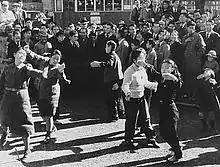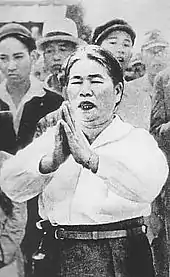Tenshō Kōtai Jingūkyō
Tenshō Kōtai Jingūkyō (jap. 天照皇大神宮教) ist eine japanische neue religiöse Bewegung, die aus dem Shintoismus hervorgegangen ist. Sie wurde von der Bäuerin Sayo Kitamura (北村 サヨ) (1900–1967) gegründet. Ihre Aktivitäten begannen 1945. Die Zahl der Mitglieder beträgt 450.000.[1]

„Tanz des Nichtselbsts“ (muga no mai) der Religionsgemeinschaft

Sayo Kitamura
Ihr Hauptsitz ist in Tabuse (田布施町, -chō), einem Ort im Landkreis Kumage, Yamaguchi, Japan.
Ihre Anhänger praktizieren einen muga no mai (無我の舞, dt. „Tanz des Nichtselbsts“ bzw. „Tanz des Nicht-Ichs“) bezeichneten Tanz, weshalb die Religion auch als die „tanzende Religion“ (踊る宗教, Odoru shūkyō, engl. the Dancing Religion) bezeichnet wird.
Literatur
- Tina Hamrin: Dansreligionen i japansk immigrantmiljö på Hawai'i. Via helbrägdagörare och Jodu shinshu-präster till nationalistisk millennarism. (English summary: The Dancing Religion in a Japanese-Hawaiian Immigrant Environment). Stockholm: Almqvist & Wiksell International, 1996. (Acta Universitatis Stockholmiensis. Stockholm Studies in Comparative Religion) - Review
- NISHIYAMA Shigeru & FUJII Takeshi: The Propagation and Spread of Tenshô Kôtai Jingûkyô within Japanese-American Society on Hawaii Island (Memento vom 21. April 2014 im Internet Archive). 1991, 1997 Institute for Japanese Culture and Classics, Kokugakuin University.
- Clark B. Offner: The Work of the Holy Spirit in the Japanese Cultural Setting (PDF; 2,3 MB), S. 57ff.
- Sayo Kitamura: Tensho Kotai Jingu-Kyo (1): The Dancing Religion, Contemporary Religions in Japan 2 (3), (1961), 26–42
- L. Carlyle May: The Dancing Religion: A Japanese Messianic Sect, Southwestern Journal of Anthropology 10 (1), (1954), 119–137
Siehe auch
- Anatta / Anātman (jap. muga)
Weblinks
- Tenshō Kōtai Jingūkyō (englisch)
- Glossary of Shinto Names and Terms - (englisch)
Einzelnachweise
This article is issued from Wikipedia. The text is licensed under Creative Commons - Attribution - Sharealike. The authors of the article are listed here. Additional terms may apply for the media files, click on images to show image meta data.